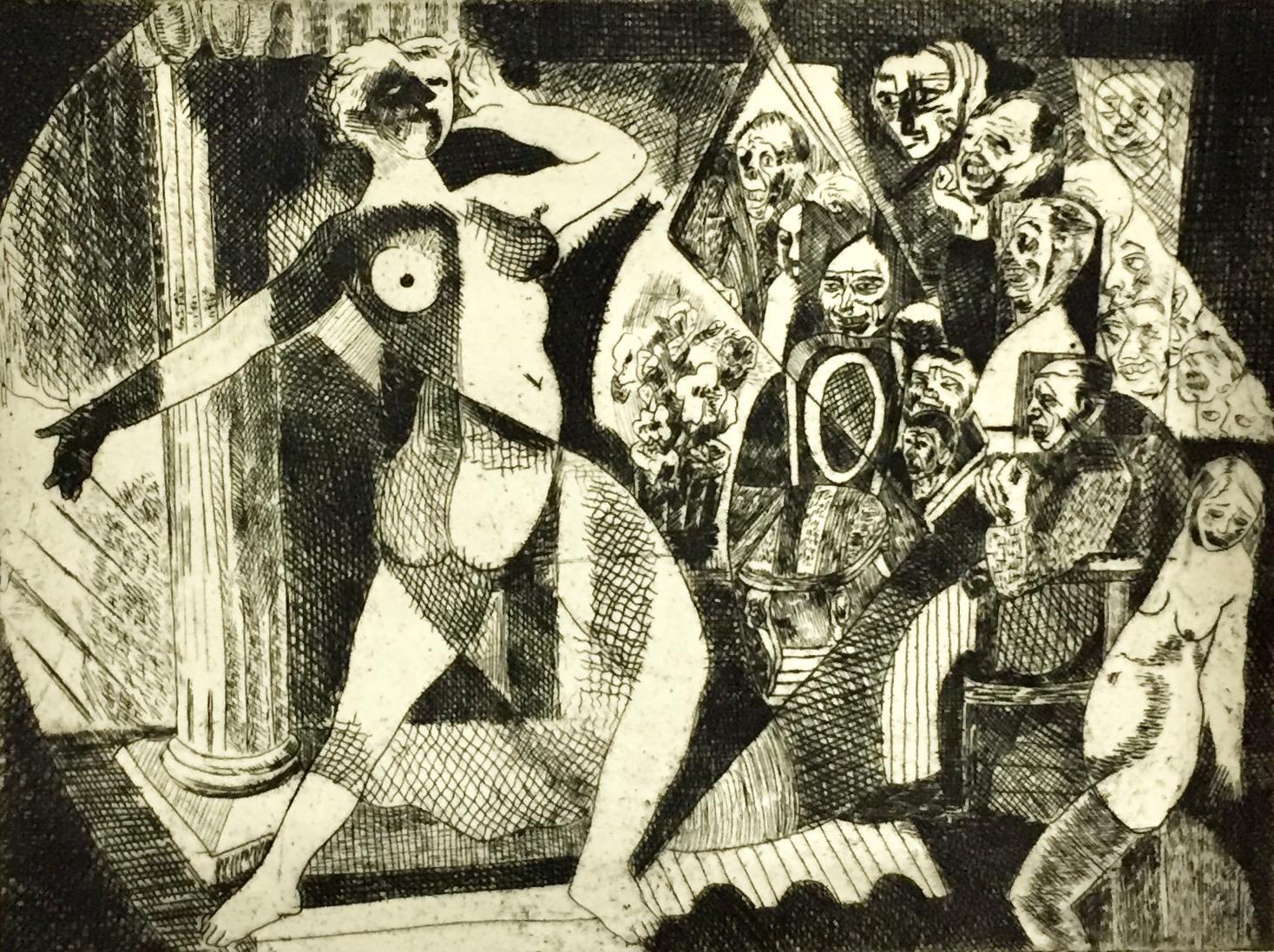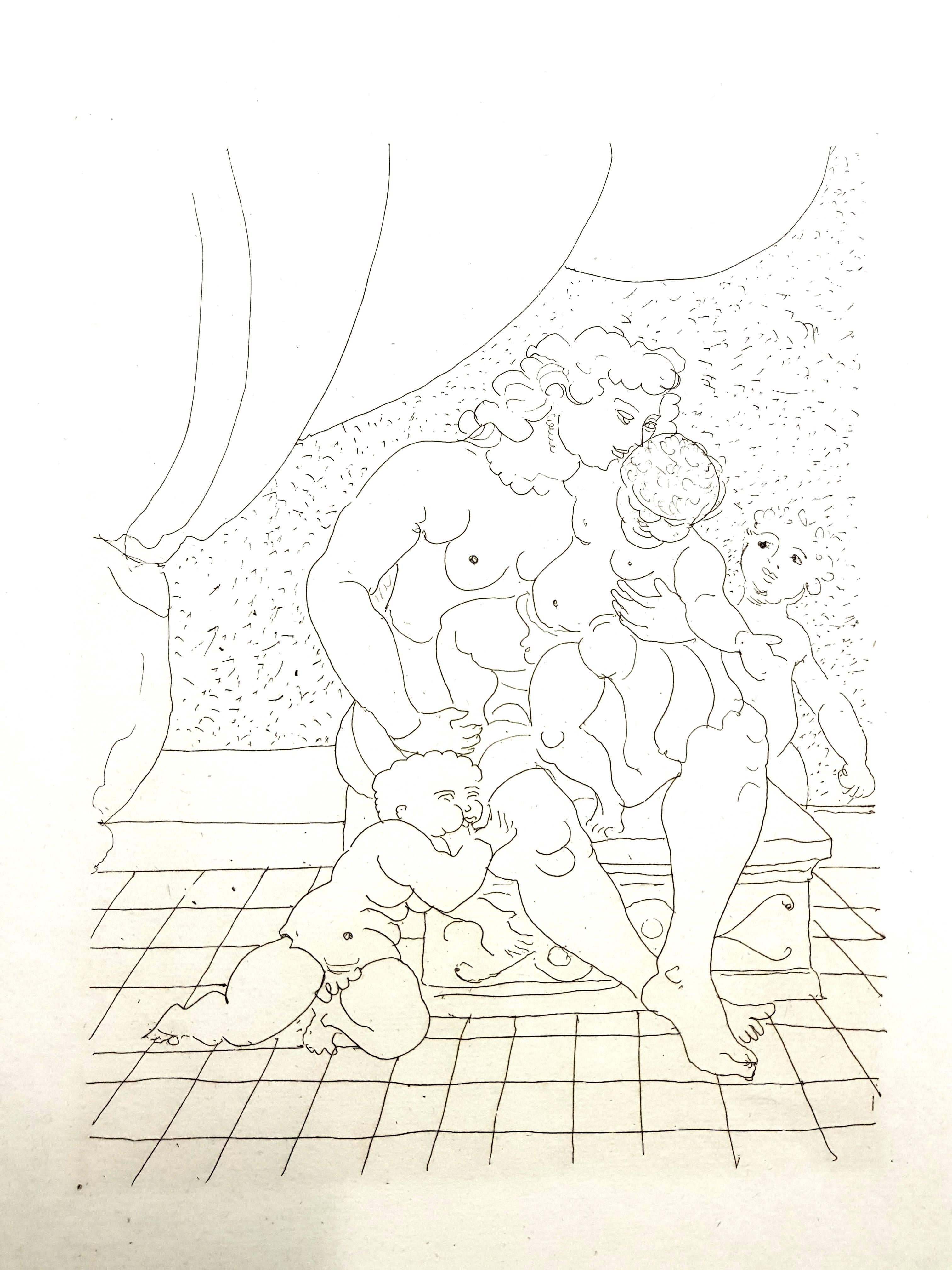Items Similar to Ossip Zadkine - Ultimate Step - Original Etching
Want more images or videos?
Request additional images or videos from the seller
1 of 5
Ossip ZadkineOssip Zadkine - Ultimate Step - Original Etching1966
1966
About the Item
Etching monogrammed in the plate.
Illustration for a Robert Ganzo's poem "Lespugue"
Editions Marcel Sautier, Paris, 1966.
Conditions: Good Conditions
Dimensions: 25,5 x 16,5 cm.
Vellum paper
Référence Czwiklitzer n°55.
1890
Zadkine was born on the 14th of July in Vitebsk, a city in Belarussia, on the Dvina.
His father Ephime teaches classical languages at the local seminar.
His mother Sophie Lester descended from Scots, who emigrated at the time of Peter the Great.
1905
His parents send him to Sunderland, in the North of England, where his mother’s family lives.
He studies English and attends modelling courses at the local Art School.
1905-1909
He travels to London without his parents permission where he attends courses at the Regent Street Polytechnicum.
In order to earn his living, he plans to work with a stonecutter.
He visits the British Museum and studies classical sculpture there.
Returns to Smolensk where he produces his first sculpture.
Goes back to London.
1909-1910
Zadkine settles in Paris and studies in the ecole Nationale des Beaux-Arts.
Finds a workshop in a building called La Ruche, in the XVe arrondissement.
1911
Zadkine presents statues and drawings at the annual Salon d’Automne and at the Salon des Indépendants.
It is the ‘cubists’ who draw his attention in Paris.
Is essentially close to Russian students who get together in a cafe of the ‘Quartier Latin’.
Has himself called Joe Zadkine until 1914.
1912-1913
Finds a room in the neighbourhood of Montparnasse, in the rue de Vaugirard.
Studies Roman sculpture.
Zadkine is immortalized by his neighbour, photographer Marc Vaux, in his new workshop.
Meets Brancusi, Guillaume Apollinaire, Jacques Lipchitz, Pablo Picasso, Antoine Bourdelle, Leopold Survage and Robert Delaunay.
Henri Matisse visits Zadkine’s workshop.
1914-1915
Exhibition at the Freie Sezession in Berlin, at De Onafhankelijken in Amsterdam (Holland) and at
the Allied Artists Association in London.
Thanks to collector Paul Rodocanachi, he can settle in a workshop in the rue Rousselet.
Becomes friends with Modigliani.
1916-1917
Works as a stretcher-bearer on the front. Produces drawings and watercolours dealing with war.
Zadkine is discharged in 1917.
He says he is ‘bodily and spiritually’ ruined by the war.
After his stay in the Epernay hospital he recovers in Bruniquel, in the southwest of France.
1918-1919
Makes a series of 20 war etchings.
Goes on with his cubic work and puts hollow and full forms against each other.
He makes contrasting profiles.
1920
Gets married on the 14 th of August in Bruniquel (France) with his neighbour from rue Rousselet, Valentine Prax (1897-1981) and withTsuguharu Foujita (1886-1968) as witness.
The first Zadkine retrospective takes place in his workshop (rue Rousselet 35).
1921
The first monograph on Zadkine’s work is published by the editor of the Italian newspaper Valori Plastici.
It is written by Maurice Raynal, one of the few French admirers of Zadkine’s new cubist work.
Most of the time, Zadkine makes deconstructed stone or wooden statues, which strike by their strongly geometric, closed forms.
Produces numerous watercolors and gouaches.
1922
The museum of Grenoble buys the golded wooden statue ‘Le Fauve’, a marble female head and a gouache.
1923-1925
Several trips to Italy.
Exhibition in Takenodai gallery in Tokyo Japan.
1926
Retrospective in Barbazanges gallery in the Parisian rue de la Boetie.
1928
The Zadkines settle in the white house behind the rue díAssas (‘La folie d’Assas’ as Zadkine called it), it will become the Zadkine museum after the death of Valentine Prax.
First retrospective in London.
1929
Andre De Ridder publishes a monograph on Zadkine.
The latter travels to Brussels for a commission and stays in Deurne, Holland with his friend
Hendrik Wiegersma.
1930
In his work, a new, agile and baroque style emerges, taking shape after the Second World War.
Exhibition of gouaches in the Arts Club of Chicago.
1933-1937
Exhibitions in Chicago, Paris, Brussels, Antwerp and New York.
First trip to the United States in 1937.
1934
Buys a big house in Les Arques (France), in the Lot, where he works in the summertime.
1935
The city of Paris buys the three meter high wooden statue Orphee for the Petit Palais.
It is given a spot in the new Musee d’Art moderne de la Ville de Paris shortly after.
1941-1945
During the Second World War, Zadkine flees to the United States.
He finds a workshop in New York.
Exhibits in Wildenstein gallery.
Stays in Arizona. From 1944 on, he teaches twice a week at the Art Students League.
Teaches for a while in North Carolina.
In September 1945, he comes back from America ‘sick, sad and penniless’.
1948-1950
Exhibition in the Stedelijk Museum of Amsterdam.
Retrospective in the Parisian Musée National d’Art moderne.
Zadkine receives the Big Sculpture Price at the Biennal event of Venice.
Exhibition in the Museum Boijmans in Rotterdam.
It is there that Zadkine presents for the first time a draft of La ville detruite.
Gives classes until 1958 at the Parisian Academie de la Grande Chaumiere.
1953
The six-meter-high war monument La ville detruite (The destroyed city)
is placed on the 15 th of May at the Leuvehaven in Rotterdam, Holland.
1955 – 1960
Zadkine makes sculptures dedicated to Vincent Van Gogh.
Presents five exhibitions, which cause stirs in Canada, where he gives lectures,
as well as in the United States.
The travelling exhibition is then presented in Seattle and San Francisco.
He has innumerable exhibitions, notably in six Japanese cities.
Devotes much time to graphical work.
1961
The Monument Van Gogh is unveiled in Auvers-sur-Oise, France.
Van Gogh statues are made during the following years for Zundert, Holland and Saint-Remy-de-Provence, France.
Big exhibition in the London Tate Gallery.
1962
First exhibition of tapestries (Galerie Lacloche, Paris).
1963
Begins the third version of La Demeure, commissioned by the Nederlandse Bank.
This statue is designed to be placed against the frontage of the central office, situated on the Amsterdam Frederiksplein.
The statue Les deux Freres Van Gogh is unveiled in Zundert, Holland, Vincent van Gogh’s Place of birth.
1965 – 1966
The photograph book Le Monde secret de Zadkine vu par D. Buchanan, featuring 25 poems by Zadkine, and the album La Foret humaine, with its 18 lithographs by Zadkine, are published.
Big retrospective in the Kunsthaus of Zurich Switzerland.
1967
Ossip Zadkine dies on the 25th of November in a Parisian hospital.
He is buried in the Montparnasse cemetery.
- Creator:
- Creation Year:1966
- Dimensions:Height: 10.04 in (25.5 cm)Width: 6.5 in (16.5 cm)Depth: 0.04 in (1 mm)
- Medium:
- Movement & Style:
- Period:
- Condition:
- Gallery Location:Collonge Bellerive, Geneve, CH
- Reference Number:1stDibs: LU16122113263
About the Seller
4.9
Platinum Seller
These expertly vetted sellers are 1stDibs' most experienced sellers and are rated highest by our customers.
Established in 2015
1stDibs seller since 2015
908 sales on 1stDibs
Typical response time: 1 hour
- ShippingRetrieving quote...Ships From: Collonge Bellerive, Geneve, Switzerland
- Return PolicyA return for this item may be initiated within 7 days of delivery.
More From This SellerView All
- Jacques Villon - Sleeping Nude - Original EtchingBy Jacques VillonLocated in Collonge Bellerive, Geneve, CHJacques Villon - Sleeping Nude - Original Etching Circa 1950 Signed in pencil Edition of 45. Dimensions : 32.7 x 25 cmCategory
1950s Modern Nude Prints
MaterialsEtching
- Jacques Villon - Nude - Original EtchingBy Jacques VillonLocated in Collonge Bellerive, Geneve, CHJacques Villon - Nude - Original Etching 1947 Signed in pencil and numbered Dimensions : 55.6 x 39.5 cmCategory
1940s Modern Nude Prints
MaterialsEtching
- André Derain - Ovid's Heroides - Original EtchingBy André DerainLocated in Collonge Bellerive, Geneve, CHAndré Derain - Ovid's Heroides Original Etching Edition of 134 Dimensions: 32 x 25 cm Ovide [Marcel Prevost], Héroïdes, Paris, Société des Cent-une, 1938...Category
1930s Modern Nude Prints
MaterialsEtching
- André Derain - Ovid's Heroides - Original EtchingBy André DerainLocated in Collonge Bellerive, Geneve, CHAndré Derain - Ovid's Heroides Original Etching Edition of 134 Dimensions: 32 x 25 cm Ovide [Marcel Prevost], Héroïdes, Paris, Société des Cent-une, 1938...Category
1930s Modern Nude Prints
MaterialsEtching
- Dufza - Paris - Quai de la Tournelle - Original Handsigned EtchingLocated in Collonge Bellerive, Geneve, CHDufza - Paris - Quai de la Tournelle - Original Handsigned Etching Circa 1940 Handsigned in pencil Dimensions: 20 x 25 cm Unumbered as issuedCategory
1940s Modern Nude Prints
MaterialsEtching
- André Derain - Ovid's Heroides - Original EtchingBy André DerainLocated in Collonge Bellerive, Geneve, CHAndré Derain - Ovid's Heroides Original Etching Edition of 134 Dimensions: 32 x 25 cm Ovide [Marcel Prevost], Héroïdes, Paris, Société des Cent-une, 1938...Category
1930s Modern Nude Prints
MaterialsEtching
You May Also Like
- Irving Guyer, Strip ActBy Irving GuyerLocated in New York, NYIrving Guyer captured the bustle of the city in a modernist style. This print is signed and titled in pencil.Category
Mid-20th Century Modern Figurative Prints
MaterialsEtching
- "Party Girl" Contemporary limited edition etchingBy Ian LaurieLocated in Brecon, PowysSigned Limited Edition Etching from Artists Studio. 12 of 25 Image 11" x 7" Matted 16" x 12" Ian Laurie was born in 1933 and is a self taught artist who made the transition from i...Category
Early 2000s Modern Nude Prints
MaterialsEtching
- NudeBy Earl StrohLocated in Dallas, TXSigned "Earl W Stroh" at lower right. This is an Artist Proof. The price includes a period wormy chestnut frame with gold leaf. The outer frame...Category
1950s Modern Nude Prints
MaterialsEtching
- "Le Repos (Rest), " Original Etching Nude signed by Victor Roux-ChampionBy Victor Roux-ChampionLocated in Milwaukee, WI"Le Repos (Rest)" is an original etching by Victor Roux-Champion. It features a nude woman lounging on a couch. The artist signed the piece lower left and wrote the edition number, 2...Category
Early 1900s Modern Figurative Prints
MaterialsEtching
- Figure au peignoirBy Henri MatisseLocated in London, GBHenri Matisse Figure au peignoir 1929 Etching on Chine appliqué on Arches Velin paper, Edition of 25 Paper size: 37.5 x 28.5 cms (14 3/4 x 11 1/4 ins) Plate Size: 16 x 6 cms (6 ¼ x 2...Category
1920s Modern Figurative Prints
MaterialsEtching
- Nu couchéBy Henri MatisseLocated in London, GBHenri Matisse Nu couché 1929 Etching on Chine appliqué on wove paper, Edition of 25 Paper size: 28.6 x 38 cms (11 1/8 x 14 5/8 ins) Plate size: 12.3 x 15.5 cms (4 3/4 x 6 1/8 ins) HM...Category
1920s Modern Figurative Prints
MaterialsEtching





